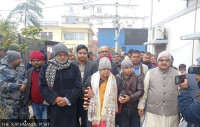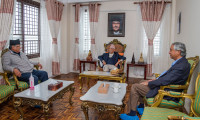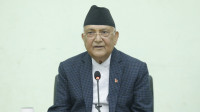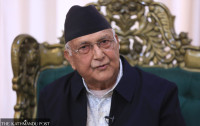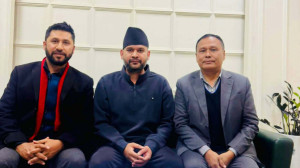Politics
Unity of the two Madhesi parties could be hamstrung by a lack of coherence among their leaders
Analysts are wary of welcoming the unification of the two Madhes-based parties as they see it as a reactive move rather than a unity born out of shared agendas.
Anil Giri
The third and fourth largest parties in Parliament, both with a large base in the Madhes, announced their merger last week in dramatic fashion. While earlier efforts at unity had failed, their April 22 merger was prompted by Prime Minister KP Sharma Oli’s ordinance seeking an amendment to a provision in the Political Party Act.
The unified party is now called the Janata Samajbadi Party, Nepal and its leaders say they want to turn it into a strong alternative political force. There are, however, questions if a new party with the same old faces can truly provide an alternative.
“This is a unity of compulsion because the government tried to split both the parties,” said Puranjan Acharya, a political analyst. “If we look at the track record of the leaders in these parties, there is enough evidence that they are to blame for destroying their own political agendas.”
Both Samajbadi Party and Janata Party, with 17 and 16 seats respectively in Parliament, have their vote base in the Madhes, especially the eastern half. Almost all directly elected lawmakers are from Province 2, except for Baburam Bhattarai (Gorkha), Mohammad Ishtiyak Rai (Banke) and Resham Chaudhary (Kailali). And they share a majority of agendas, with amendments to the constitution being the most important.
Analysts say that the major challenge the newly formed party faces will be to manage the egos of its leaders, which largely led to the past failures to unite.
Past mergers had largely failed because of one leader—Upendra Yadav. Even within the Samajbadi Party, leaders were not happy with Yadav, which was why some lawmakers were quick to take Oli’s bait to split the party.
The Samajbadi Party itself was formed in May last year after a merger between Yadav’s Sanghiya Samajbadi Forum and Baburam Bhattarai’s Naya Shakti.
The Sanghiya Samajbadi Forum was the latest avatar of a number of parties that Yadav has led over the years with the suffix ‘Forum’, a continuation of a non-governmental organisation that he once ran—the Madhesi Janadhikar Forum. Yadav had later turned it into a political party.
Bhattarai had formed Naya Shakti after the promulgation of the constitution in 2015.
The Rastriya Janata Party meanwhile was formed by six Madhes-based parties that were under the umbrella of the Samyukta Loktantrik Madhesi Morcha. They had united in April 2017, on the eve of the elections.
Chandrakishore, a journalist and commentator who closely follows Madhes politics, said that he is not too optimistic about the recent unity of the two parties when it comes to national politics.
“Some political circumstances created by Prime Minister Oli prompted them to merge,” Chandrakishore told the Post. “The only good thing is that they managed to surprise Oli.”
According to Chandrakishore, Oli has attempted to alienate and discredit the Madhes since the constitution drafting process in 2015.
“Oli had brought the ordinance with an ulterior motive and these parties gave him a befitting answer. That’s it,” he said.
Observers also point out a lack of coherence among the constituent parties of the Janata Samajbadi Party as its top leaders come from different schools of thought.
Among the Samajbadi Party leaders, Bhattarai carries the legacy of the decade-long Maoist war. He is a well-known face in Nepali politics but he lacks a strong public base. Yadav was a teacher before becoming a revolutionary communist and the champion of the Madhesi cause. His burning of the 2007 interim constitution in Maitighar catapulted him into national politics.
Ashok Rai was a UML vice-chair before he quit to form the Sanghiya Samajbadi Party-Nepal. In June 2015, Rai decided to merge with Yadav’s Madhesi Janadhikar Forum-Nepal to form the Sanghiya Samajbadi Forum-Nepal. Rai represents the indigenous community in the newly formed party, but he too lacks broad public support.
When it comes to the Janata Party, the patriarch Mahantha Thakur was a long-time Congress leader, and by that token, claims to be a democrat. Rajendra Mahato is an active leader, who is vocal and has a large vote base. Mahato had surprised everyone by defeating the Congress’ Bimalendra Nidhi in the 2017 elections in the latter’s constituency.
If there’s any leader who could challenge Yadav in the new party, it will be Mahato, say party members.
Mahendra Raya Yadav also comes from the UML. He had parted ways with Thakur’s Tarai Madhes Loktantrik Party to form his own Tarai Madhes Sadbhawana Party. Insiders don’t view him as an assertive leader.
The two other leaders in the Janata Party—Raj Kishore Yadav and Anil Jha—have already expressed reservations about the unification. During earlier negotiations for unity, their major concern was losing relevance.
Analyst CK Lal, who is also a columnist for the Post, said that he is not very excited about the recent development.
“Yes, the two parties managed to save themselves by announcing the merger,” Lal told the Post. “If there is any further damage, they decided to face it together.”
The new party has yet to come up with its policy and programme and agenda but a leader from the former Janata Party said that all top leaders have their own agendas and strategies.
At least four leaders—Bhattarai, Thakur, Yadav and Mahato—will want to exercise executive power in the party, according to the leader who spoke on condition of anonymity.
Yadav may offer Thakur the party chair, but only after the general convention, keeping the post with himself for now. In the Samajbadi Party, Bhattarai was the chair of the federal council while Yadav led the central committee.
If Yadav keeps the party chair post in the new party, Bhattarai will try to retain the federal council chair.
According to insiders, the party could form a 12-member central secretariat with six members each from the Samajbadi Party and the Janata Party.
This, however, will raise a question regarding Mahato’s role.
Mahato, according to leaders, has proposed that Thakur be the patron of the new party with a four-member praesidium of Bhattarai, Yadav, Rai and himself.
“Or he will make a pitch for four chairs—Bhattarai, Yadav, Thakur and himself—if the proposal of Thakur as patron fails,” the leader told the Post.
Two party leaders who also spoke on condition of anonymity said that Bhattarai is likely to claim leadership of the Parliamentary Party, a post Mahato could also demand.
The newly formed party is still not sure how it will manage two other leaders—Anil Jha and Raj Kishore Yadav–who have not signed the party merger document, saying they will agree to unity only if they are assured “respectable space”.
Both Jha and Raj Kishore are in favour of giving Thakur the top honorary position and forming a secretariat of all senior leaders from both sides, including them.
One youth leader, who also spoke on condition of anonymity, said personal egos of some top party leaders, hierarchy and protocol, past bitter relations between some leaders, and a lack of concrete ideology may be obstacles to cementing their ties.
But political analysts say how the leadership evolves in the days to come will determine the new party’s course.
For the Janata Samajbadi Party to make its name as an alternative force, its leaders also need to capitalise on the political vacuum created by the Nepali Congress and the Nepal Communist Party (NCP).
“This unity announcement is not proactive but reactive. There’s not much to think about and analyse about this reactive move,” said Lal.
According to Lal, if the two parties had united in a proper manner, they could have become an alternative force, as the main opposition Nepali Congress is lost and the ruling Nepal Communist Party is a divided house.
“This is only the first step of the [unity] process. The direction is good but it depends on how far they can go together,” said Lal. “For now, we can only say that they have administrative unity, which cannot ensure a political struggle.”
Tika R Pradhan contributed reporting.




 6.31°C Kathmandu
6.31°C Kathmandu
